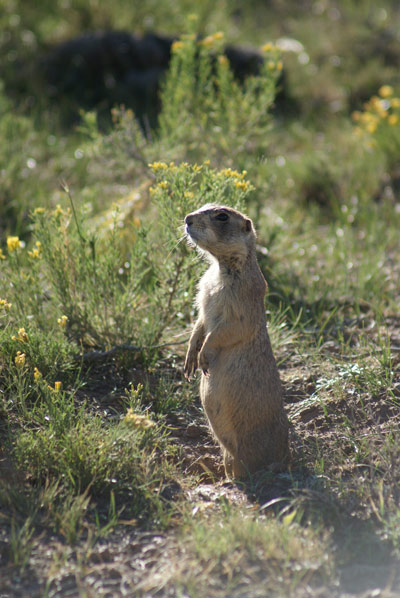Because prairie dogs are both an important component of the ecosystem and, in some cases, damaging to other resources within and adjacent to the parks, their management is important and complex.
It is NPS policy to conserve and recover prairie dogs wherever possible. However, populations can be controlled for purposes of human health and safety, good neighbor relations, and to stop or prevent damage to park resources and facilities.
Black-tailed Prairie Dogs

USGS
At FOLS, prairie dogs may be damaging historic wagon ruts of the Santa Fe and Oregon trails. At BEOL, their activities have threatened a prairie restoration site, and at both BEOL and SAND they have threatened archeological sites and caused concerns with adjacent landowners who do not want prairie dogs to move from the park onto their land. In the last few years, managers at FOLS and BEOL have removed prairie dogs in response to these concerns. At SAND, the NPS is developing a black-tailed prairie dog management plan with the goal of managing for long-term, self-sustaining prairie dog populations while avoiding negative impacts to adjacent landowners.
The management plan under development at SAND discusses management options for controlling prairie dogs, including: use of vegetative barriers and/or grazing management to discourage colony expansion; conservation easements; use of fencing and other visual barriers to prevent colony expansion; live trapping and translocation of prairie dogs; directed sport shooting to site-specific areas; and use of approved rodenticides to control populations. To avoid adverse impacts to vegetation from high prairie dog densities, the plan suggests a goal of maintaining 10 prairie dogs per acre at SAND. Under the plan, monitoring of both prairie dogs and vegetation would be conducted (Sovell 2008).
Additional information is needed on the prairie dog populations at SAND, FOLS, and BEOL, their dispersal to adjacent lands, the degree of damage they may cause, and the results of control efforts. To address these needs, a project is beginning at FOLS, BEOL, and SAND, as well as Scotts Bluff National Monument in Nebraska. The project (Status and Management of Black-tailed Prairie Dogs on Small Cultural National Parks of the Western Great Plains), by Cully (USGS) and Willson (NPS) will collect mark-recapture data for multiple years. At each park the study will establish baseline information on the distribution, abundance, population growth rates, and dispersal of resident prairie dogs. Monitoring was already underway at BEOL, but the new study will provide additional information.
At FOLS, researchers will map prairie dog burrows and determine whether they are active or inactive, which will assist in assessing soil disturbance in and near the trail ruts. They will also identify the occurrence of species associated with prairie dog colonies at each park. The project results will be valuable in developing science-based management plans to control adverse impacts of prairie dogs on park resources and adjacent lands, while conserving prairie dogs and associated species.
Gunnison’s Prairie Dogs
As discussed previously, Gunnison’s prairie dog populations may have a more difficult time recovering from the sylvatic plague than other species. Outbreaks of plague at PEFO, within the SCPN, killed most colonies in the park. High populations at AZRU were leading to potential concerns for vegetation and adjacent land onwers, but a die-off due to plague in the last decade reduced populations and eleminated the concerns for other resources. Development of a management plan for prairie dogs at PEFO has been noted as an ongoing need.
Prepared by Patricia Valentine-Darby, Southern Plains Network Inventory and Monitoring Program, 2009.
Part of a series of articles titled Prairie Dogs of the American Southwest.
Last updated: July 27, 2015
